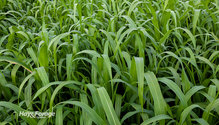Close
In the August/September “Feed Analysis” column, we delved into forage protein and its associated complex feed analysis measures. The nitrogen and amino acids in forage are valuable, with protein
Several scientists have contributed enormously to the dairy industry during the past 50 years, and Dave Mertens might be at the top of the list. If you still need convinced of this reasoning, I invite
Despite alfalfa’s popularity, there are many reasons producers plant and feed alternative forages. Seeding grass species, cover crops, or cocktail mixes may be viable solutions to alfalf
Being an early adopter is a double-edged sword. On the one hand, it’s possible to gain a competitive advantage; on the other hand, mistakes need to be made in real time as there is little experience
Throughout Northern U.S. dairy regions, forage harvester hay heads will soon be replaced with those of a corn silage ilk, and processor rolls will be cranked down
It's corn silage harvest season — a short window of time that affects dairy profitability all year long. What can go wrong?
Have you ever driven past an alfalfa field a few days after harvest and noticed distinct tracks where the equipment traveled?
Let’s be clear on one thing: Corn silage is the primary feed source of the dairy industry
On many farms, silage and haylage are the primary forms of forage harvest and preservation
Sorghum and its many variations now appear in fields across the U.S. with virtually no latitude or longitude limitations when hybrids are properly selected. Their ability to tolerate drought, generate
With the 2021 corn silage now in storage, we’re gaining a clear understanding of what its nutritional value will bring to dairy and beef operations
In a corn silage system, producers are served by two equally important groups: the nutritionists, who help feed the silage, and the agronomists, who help grow it
Sorghum is a key forage source for dairy herds in many areas across the United States with dry climates. But it has also been successfully grown under more humid conditions
There are certain practices or technologies that seem to be heavily debated or discussed over the course of time. Kernel processing score and corn hybrid selection are two different topics
Harvest corn silage – check. Apply inoculant – check. Pack and cover bunkers and piles – check. This is what many producers’ to-do lists look like at this point in the season. Despite
Somewhere between the territories of making dry hay and chopping haylage is the land of baleage. Its acreage is expanding at a rate that would gain compliments from the former Macedonian king
If you’re even a semi-regular reader of eHay Weekly or Hay & Forage Grower, you already know how we feel about the forage world’s reluctance to rid the industry of quality terms derived solely
At a recent field day, Brody Stapel explained how their farm is transitioning away from alfalfa by feeding more winter cereals and summer annual forage mixtures.Double Dutch Dairy, near Cedar Grove, Wi
At no point in the history of U.S. agriculture have winter cereal grains been relied upon as a staple forage resource more than they currently are
Picture yourself with the playbook in your hands as several key decisions loom while coaching your team in the final minutes of the game. Your team is relying on you to put them in the right position
..
Visit our partner publications:
Hoard's Dairyman | Journal of Nutrient Management



















